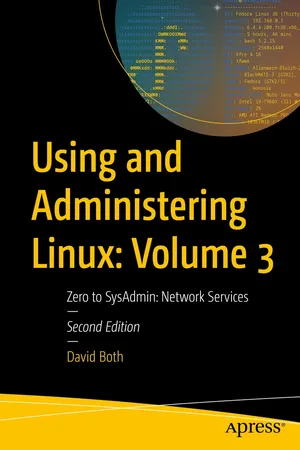
- English
- ePUB (mobile friendly)
- Only available on web
About This Book
In Using and Administering Linux: Volume 3 you'll work with multiple VMs on a single physical host to create a network in which to sharpen your sysadmin skills. Chapters have been fully updated to Fedora Linux 38 with expanded content and figures as well brand new material on the BTRFS file system, using Zram for swap, NetworkManager, automation with Ansible, as well as systemd.
Focusing on network and other advanced services, this second edition of the final series volume builds upon the skills you have learned so far in volumes 1&2 and will depend upon the virtual network and VMs created there. Start by reviewing the administration of Linux servers and install and configure various Linux server services such as DHCP, DNS, NTP, and SSH server that will be used to provide advanced network services. You'll then learn to install and configure servers such as BIND for name services, DHCP for network host configuration, and SSH for secure logins to remote hosts.
Other topics covered include public/private keypairs to further enhance security, SendMail and IMAP and antispam protection for email, using Apache and WordPress to create and manage web sites, NFS, SAMBA, and Chrony. This volume also covers SELinux and its use in making your systems even more secure., You will learn to build RPMs to be used to distribute automation scripts. All of these services are installed on a single server host over the course of the book and by the time you are finished you will have a single server that provides these services for your network.
What You Will Learn
- Install, configure, and manage several Linux server services such as email with spam management and single and multiple web sites
- Work with NTP time synchronization, DHCP, SSH, and file sharing with Unix/Linux and Windows clients
- Create RPMs for distribution of scripts and administrative programs.
- Understand and work withenhanced security.
Who This Book Is For
Those who are already Linux power users – SysAdmins who can administer Linux workstation hosts that are not servers – who want to learn to administer the services provided by Linux servers such as web, time, name, email, SSH, and more.
Frequently asked questions
Information
Table of contents
- Cover
- Front Matter
- 42. Server Preparation
- 43. Name Services
- 44. Routing
- 45. Remote Access with SSH
- 46. Security
- 47. Back Up Everything – Frequently
- 48. Introducing Email
- 49. Advanced Email Topics
- 50. Combating Spam
- 51. Apache Web Server
- 52. WordPress
- 53. Mailing Lists
- 54. Remote Desktop Access
- 55. Advanced Package Management
- 56. File Sharing
- 57. Where Do I Go from Here?
- Back Matter